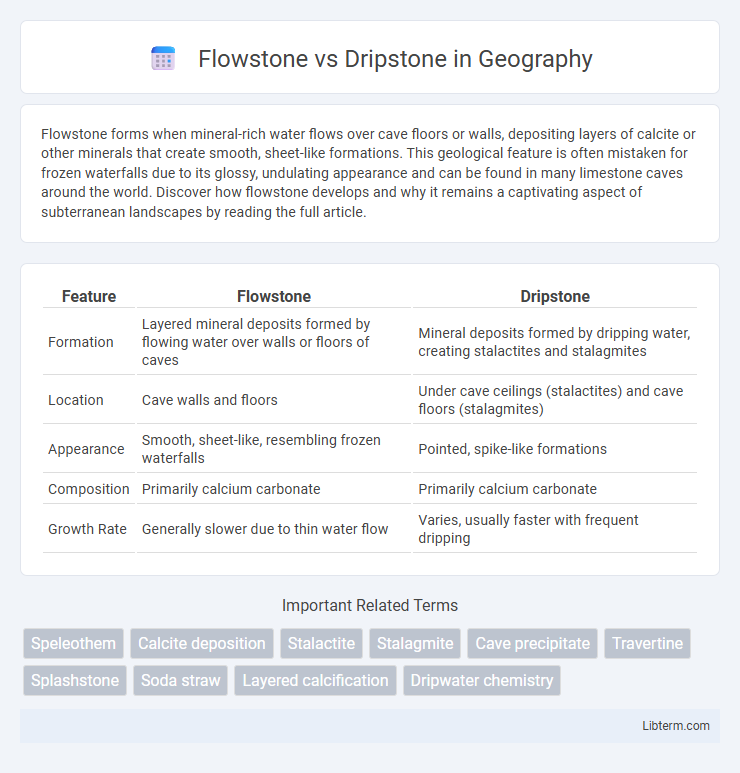Flowstone forms when mineral-rich water flows over cave floors or walls, depositing layers of calcite or other minerals that create smooth, sheet-like formations. This geological feature is often mistaken for frozen waterfalls due to its glossy, undulating appearance and can be found in many limestone caves around the world. Discover how flowstone develops and why it remains a captivating aspect of subterranean landscapes by reading the full article.
Table of Comparison
| Feature | Flowstone | Dripstone |
|---|---|---|
| Formation | Layered mineral deposits formed by flowing water over walls or floors of caves | Mineral deposits formed by dripping water, creating stalactites and stalagmites |
| Location | Cave walls and floors | Under cave ceilings (stalactites) and cave floors (stalagmites) |
| Appearance | Smooth, sheet-like, resembling frozen waterfalls | Pointed, spike-like formations |
| Composition | Primarily calcium carbonate | Primarily calcium carbonate |
| Growth Rate | Generally slower due to thin water flow | Varies, usually faster with frequent dripping |
Introduction to Flowstone and Dripstone
Flowstone forms when mineral-rich water flows smoothly over walls or floors of caves, depositing layers of calcite that create a smooth, sheet-like structure. Dripstone develops through the precipitation of minerals from dripping water, forming stalactites and stalagmites with distinct, elongated shapes. Both types of speleothems consist primarily of calcium carbonate but exhibit different textures and growth patterns based on water movement and deposition methods.
Formation Processes of Flowstone and Dripstone
Flowstone forms through the continuous deposition of calcium carbonate from mineral-rich water flowing over rock surfaces, creating smooth, sheet-like layers. Dripstone, including stalactites and stalagmites, develops from water droplets that deposit minerals as they drip and evaporate in caves, resulting in elongated, pillar-like structures. The distinct formation processes are influenced by water movement, mineral concentration, and environmental conditions, which determine the growth patterns and textures of flowstone and dripstone formations.
Physical Characteristics of Flowstone
Flowstone forms smooth, sheet-like deposits of calcite or other minerals on cave floors and walls, characterized by its glossy, layered appearance. It develops from thin films of flowing water that spread mineral-rich solutions evenly, creating broad, gently sloping surfaces unlike the icicle-shaped structures of dripstone stalactites and stalagmites. The texture of flowstone is often uniform and banded, emphasizing its continuous precipitation pattern distinct from the more discrete, point-specific growth of dripstone formations.
Physical Characteristics of Dripstone
Dripstone, typically formed from the slow accumulation of calcium carbonate deposits, exhibits a porous and rough texture with pointed, icicle-like structures such as stalactites and stalagmites. These formations display varying colors due to mineral impurities, ranging from white to brown, and often have a crystalline, layered appearance. Unlike the smoother, banded flowstone, dripstone surfaces are more irregular and jagged due to their gradual, drop-by-drop mineral deposition process.
Key Differences Between Flowstone and Dripstone
Flowstone forms as smooth, sheet-like deposits of calcium carbonate on cave floors and walls from thin water films, while dripstone includes stalactites and stalagmites created by water droplets depositing minerals. Flowstone typically develops layered, sheet textures due to continuous mineral precipitation, whereas dripstone exhibits distinct shapes like icicles or columns from drip-wise deposition. The key difference lies in their formation processes--flowstone grows from flowing water sheets, dripstone forms from individual water droplets.
Common Locations for Flowstone and Dripstone
Flowstone typically forms on cave floors and walls where mineral-rich water flows smoothly over surfaces, commonly found in limestone caves such as those in Mammoth Cave, Kentucky, or Carlsbad Caverns, New Mexico. Dripstone, including stalactites and stalagmites, forms where water drips slowly, depositing minerals primarily in cave ceilings and floors, with notable occurrences in Luray Caverns, Virginia, and the Jenolan Caves in Australia. Both types prominently appear in karst environments where calcium carbonate dissolution and precipitation processes dominate.
Geological Significance and Uses
Flowstone forms in caves from the deposition of calcium carbonate-rich water flowing over walls or floors, creating smooth, sheet-like mineral layers, whereas dripstone, including stalactites and stalagmites, develops from mineral-laden water droplets depositing calcite at discrete points. Both formations serve as valuable paleoclimatic records, helping geologists reconstruct past environmental conditions through isotopic and trace element analysis. In practical uses, flowstone surfaces can indicate hydrological patterns in karst systems, while dripstone structures inform cave conservation efforts and tourism management due to their aesthetic and scientific importance.
Visual Identification Tips
Flowstone features smooth, sheet-like formations with glossy surfaces, often resembling cascading waterfalls on cave walls, while dripstone consists of stalactites and stalagmites with rougher, elongated, and pointed structures formed by mineral deposits from dripping water. Flowstone's coloration varies from white to amber hues with layered bands, contrasting with the typically crystalline, sometimes translucent appearance of dripstone formations. Observing the texture and shape differences--flowstone's continuous, curtain-like spread versus dripstone's discrete, icicle-like growths--provides clear visual identification cues.
Flowstone and Dripstone in Cave Ecosystems
Flowstone forms from mineral-rich water flowing over cave floors or walls, creating smooth, sheet-like deposits primarily composed of calcite or aragonite that contribute to cave stability and aquatic habitats. Dripstone, including stalactites and stalagmites, results from mineral precipitation at water drip points, playing a key role in microhabitat formation for cave-dwelling organisms and indicating past hydrological conditions. Both flowstone and dripstone influence cave ecosystem biodiversity by providing diverse surfaces for microbial colonization and shelter for invertebrates.
Conservation and Preservation Efforts
Flowstone and dripstone are delicate speleothems formed by mineral deposits in caves, requiring targeted conservation strategies to prevent damage from human interaction and environmental changes. Efforts focus on maintaining stable cave microclimates and limiting physical contact, as alterations can disrupt mineral precipitation processes essential to both formations. Preservation initiatives often include controlled access, monitoring of water chemistry, and public education to safeguard these irreplaceable geological features.
Flowstone Infographic

 libterm.com
libterm.com